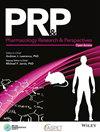利用低毒 DNA 染色染料进行高含量成像分析,预测药物暴露后的细胞周期分布情况
IF 2.9
4区 医学
Q2 PHARMACOLOGY & PHARMACY
引用次数: 0
摘要
干扰细胞周期进展一直是抗癌药物的重要特性之一。在本研究中,我们利用受体细胞暴露于药物并用低毒 DNA 染料 SiR-DNA 进行 DNA 染色后的高含量成像数据开发了细胞周期预测模型。为此,我们利用了导入了基于泛素化荧光细胞周期指示剂(Fucci)的 HeLa 和 MCF7 细胞。暴露于抗癌药物 36 小时后,使用 OperettaCLS 对表达 Fucci 的癌细胞进行高含量成像分析;对细胞核进行分割,并使用成像分析软件 Harmony 计算以 SiR-DNA 染色为特征的每个细胞核的形态和强度特性。为了进行训练,我们使用 Fucci 系统将细胞分为细胞周期的各个阶段。我们随机抽取了训练数据(n = 7500)和验证数据(n = 2500),并使用四种监督机器学习算法开发了细胞周期 G1、S 早期和 S/G2/M 期的二元分类预测模型。通过 10 倍交叉验证,我们选出了性能最佳的随机森林模型,准确率约为 75%-87%。在特征重要性方面,预计与细胞周期有生物学相关性的变量,如信号强度和核大小,排名靠前,这表明了模型的有效性。这些结果表明,只需利用目前使用DNA染色剂荧光图像的预测模型,就能预测癌细胞的细胞周期,该模型可用于未来的体内外药物敏感性诊断。本文章由计算机程序翻译,如有差异,请以英文原文为准。
Prediction of cell cycle distribution after drug exposure by high content imaging analysis using low‐toxic DNA staining dye
Interference in cell cycle progression has been noted as one of the important properties of anticancer drugs. In this study, we developed the cell cycle prediction model using high‐content imaging data of recipient cells after drug exposure and DNA‐staining with a low‐toxic DNA dye, SiR‐DNA. For this purpose, we exploited HeLa and MCF7 cells introduced with a fluorescent ubiquitination‐based cell cycle indicator (Fucci). Fucci‐expressing cancer cells were subjected to high‐content imaging analysis using OperettaCLS after 36‐h exposure to anticancer drugs; the nuclei were segmented, and the morphological and intensity properties of each nucleus characterized by SiR‐DNA staining were calculated using imaging analysis software, Harmony. For the use of training, we classified cells into each phase of the cell cycle using the Fucci system. Training data (n = 7500) and validation data (n = 2500) were randomly sampled and the binary classification prediction models for G1, early S, and S/G2/M phases of the cell cycle were developed using four supervised machine learning algorithms. We selected random forest as the model with the best performance through 10‐fold cross‐validation; the accuracy rate was approximately 75%–87%. Regarding feature importance, variables expected to be biologically related to the cell cycle, for example, signal intensity and nuclear size, were highly ranked, suggesting the validity of the model. These results showed that the cell cycle can be predicted in cancer cells by simply exploiting the current prediction model using fluorescent images of DNA‐staining dye, and the model could be applied for the use of future ex vivo drug sensitivity diagnosis.
求助全文
通过发布文献求助,成功后即可免费获取论文全文。
去求助
来源期刊

Pharmacology Research & Perspectives
Pharmacology, Toxicology and Pharmaceutics-General Pharmacology, Toxicology and Pharmaceutics
CiteScore
5.30
自引率
3.80%
发文量
120
审稿时长
20 weeks
期刊介绍:
PR&P is jointly published by the American Society for Pharmacology and Experimental Therapeutics (ASPET), the British Pharmacological Society (BPS), and Wiley. PR&P is a bi-monthly open access journal that publishes a range of article types, including: target validation (preclinical papers that show a hypothesis is incorrect or papers on drugs that have failed in early clinical development); drug discovery reviews (strategy, hypotheses, and data resulting in a successful therapeutic drug); frontiers in translational medicine (drug and target validation for an unmet therapeutic need); pharmacological hypotheses (reviews that are oriented to inform a novel hypothesis); and replication studies (work that refutes key findings [failed replication] and work that validates key findings). PR&P publishes papers submitted directly to the journal and those referred from the journals of ASPET and the BPS
 求助内容:
求助内容: 应助结果提醒方式:
应助结果提醒方式:


